Mention Dihua Street (迪化街) and longtime Taipei residents are sure to recount youthful trips to the century-old area to stock up on Lunar New Year treats, or later visits to give their children a taste of the old city.
For most of the year, Dihua, located close to the Tamsui River in Taipei’s historic Datong District (大同區), is a sedate street lined with traditional tailors and Chinese medicine pharmacies. In the weeks leading up to the Lunar New Year, however, it transforms into a Rabelaisian market with hundreds of stalls selling all manner of bulk confections, dried goods and toys.
Gone are the days when mom-and-pop stalls would ply their trade under a low-watt light bulb. Today, university-aged hawkers line the brightly lit narrow street and try to out-barker each other in an attempt to convince potential customers to buy a handful of candy or a kilo of nuts.
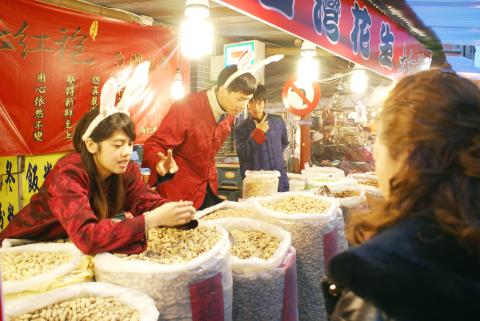
Photo: Noah Buchan, Taipei Times
And these yappers can get pretty aggressive. One animated hustler grabbed me by the arm and pushed me toward a mound of fluorescent red and orange dried seafood.
“You try,” he commanded with a toothy grin as two female cohorts waved strings of dried squid in my face. Within a few minutes, the stand had given away about a kilogram of the product.
Another shop had hired three girls dressed in tight-fitting qipaos to form a human wall extending into the middle of the bustling street, effectively forcing passersby into their neon-lit stall stuffed with jellies.
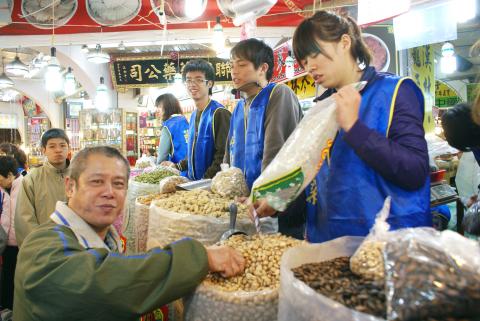
Photo: Noah Buchan, Taipei Times
Other impresarios are subtler — though only marginally. Standing on a ladder and wearing a gorilla mask, a young man called me over and insisted I try his stand’s pistachio nuts, “the freshest on the street.” Another, dressed in a pink bunny suit, hopped around a table topped with plastic bins overflowing with foil-wrapped chocolate.
Costumes, orations, gamboling: Dihua Street has become as much about playful performance as it is about selling produce. When asked if his amateur dramatics helped to boost sales, a guy dressed as a rabbit said he wasn’t sure.
“Just standing around for 10 hours, though, would be boring,” he said. “This is fun and attracts a lot of attention.” A family stopped to take a photo with him.
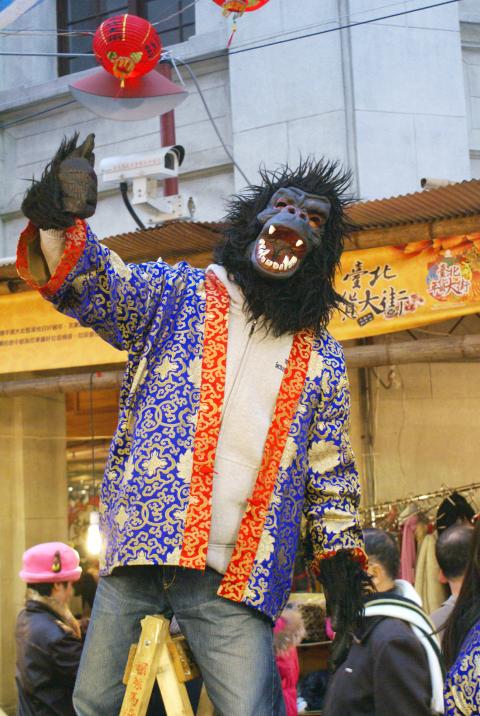
Photo: Noah Buchan, Taipei Times
Further up the street, a woman surnamed Huang emerged from the scrum nibbling on a jellybean and loaded down with nuts and dried seafood.
The middle-aged housewife from Sindian said that she was stocking up for the scores of relatives who will descend on her home to ring in the Year of the Rabbit.
Asked about the pushy young hawkers vying for her attention, Huang said that it lent Dihua Street a refreshing vibe. “It certainly feels more alive than the past few years,” she said.
That sentiment was echoed by Titan Wu (吳孟寰), who has worked at Dihua Street’s Hsiahai City God Temple (霞海城隍廟) for six years.
“More and more young people are flocking here for work and sightseeing,” he said. Wu said a renovation project spear-headed by the Taipei City Government was transforming Dihua into a tourist hot spot — and not just in the weeks leading up to the Lunar New Year.
“In the future it might look like this all year round,” he said pointing to the bustling thoroughfare out front of the temple.
Back on the street, sellers said they are doing brisk business this year.
“It’s because the economy is better,” said a woman overseeing a troupe of fledgling entrepreneurs wearing traditional Chinese costumes. “Dressing them up like this helps to beat the competition.”
Anyone heading to Dihua Street is advised to leave their car or scooter at home and take public transportation as there is very limited parking. Dihua Street is a 15-minute walk west down Minsheng East Road from the Shuanglian MRT Station (雙連捷運站). A shuttle bus service leaves from the station’s Exit 2 every 10 minutes and will run until Feb. 1.

In the March 9 edition of the Taipei Times a piece by Ninon Godefroy ran with the headine “The quiet, gentle rhythm of Taiwan.” It started with the line “Taiwan is a small, humble place. There is no Eiffel Tower, no pyramids — no singular attraction that draws the world’s attention.” I laughed out loud at that. This was out of no disrespect for the author or the piece, which made some interesting analogies and good points about how both Din Tai Fung’s and Taiwan Semiconductor Manufacturing Co’s (TSMC, 台積電) meticulous attention to detail and quality are not quite up to

April 21 to April 27 Hsieh Er’s (謝娥) political fortunes were rising fast after she got out of jail and joined the Chinese Nationalist Party (KMT) in December 1945. Not only did she hold key positions in various committees, she was elected the only woman on the Taipei City Council and headed to Nanjing in 1946 as the sole Taiwanese female representative to the National Constituent Assembly. With the support of first lady Soong May-ling (宋美齡), she started the Taipei Women’s Association and Taiwan Provincial Women’s Association, where she
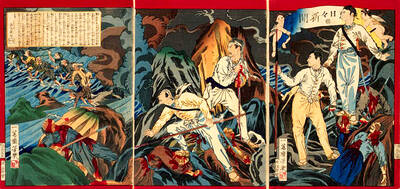
It is one of the more remarkable facts of Taiwan history that it was never occupied or claimed by any of the numerous kingdoms of southern China — Han or otherwise — that lay just across the water from it. None of their brilliant ministers ever discovered that Taiwan was a “core interest” of the state whose annexation was “inevitable.” As Paul Kua notes in an excellent monograph laying out how the Portuguese gave Taiwan the name “Formosa,” the first Europeans to express an interest in occupying Taiwan were the Spanish. Tonio Andrade in his seminal work, How Taiwan Became Chinese,
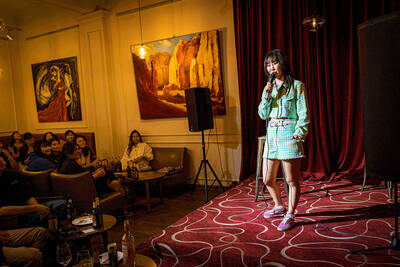
Mongolian influencer Anudari Daarya looks effortlessly glamorous and carefree in her social media posts — but the classically trained pianist’s road to acceptance as a transgender artist has been anything but easy. She is one of a growing number of Mongolian LGBTQ youth challenging stereotypes and fighting for acceptance through media representation in the socially conservative country. LGBTQ Mongolians often hide their identities from their employers and colleagues for fear of discrimination, with a survey by the non-profit LGBT Centre Mongolia showing that only 20 percent of people felt comfortable coming out at work. Daarya, 25, said she has faced discrimination since she